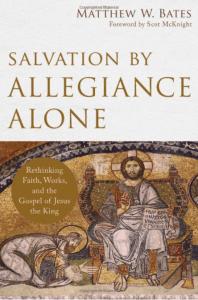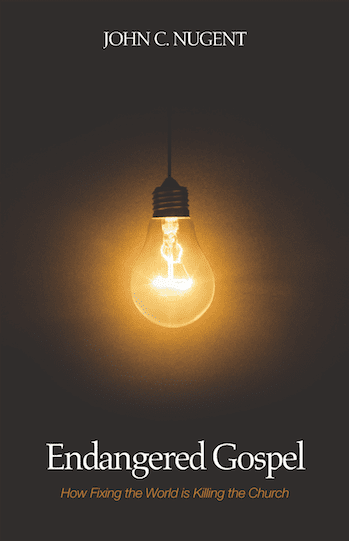This post is by John Frye, and records an experience of preparing a sermon and suddenly seeing a gospel text in new light as a result of his reading of The King Jesus Gospel: The Original Good News Revisited:
One of the more interesting observations I have made about Scot’s book on the gospel is that it suddenly sheds light on texts I would perhaps not have identified as “gospel” texts before. So here I am preparing for a sermon and one such moment occurs. Here are my thoughts on the “Story gospel” of Paul in 1 Timothy:
Serving as a pivot within the Book of 1 Timothy is the brief exhortation text of 1 Timothy 3:14-16 (see below). Paul’s emphasis is that Christian behavior in the community of God is fueled by the historical events unfolded in the life of Jesus Christ.
Although I hope to come to you soon, I am writing you these instructions so that, if I am delayed, you will know how people ought to conduct themselves in God’s household, which is the church of the living God, the pillar and foundation of the truth. Beyond all question, the mystery from which true godliness springs is great:
He appeared in the flesh,
was vindicated by the Spirit,
was seen by angels,
was preached among the nations,
was believed on in the world,
was taken up in glory.Here’s the big observation: to exhort people to live right, Paul grounds that living in the gospel Story about Jesus. This gospel gives rise to holiness!
Timothy has been charged to bring order to the disordered church in Ephesus (see 1:3-4, 18), a disorder caused by false teachers and teachings. Until Paul arrives Timothy is exhorted to define and command obedience to godly, community-wide behavior.
An interesting feature is how Paul sees the church as the family of God. Chp 3: 14-15 look back on the behavior within the gathered assembly and the kinds of leaders needed as well as look forward to groups within the church that need some behavioral changes.
The believing community, the community where gospel holiness is to take root, is defined as
1. the oikos (family, house) of God exhibiting the intimate relationships of familial love;
2. the ekklesia (church) of the living God reminding the community that they are related to a dynamic, active Person;
3. the “pillar” and “foundation” of the truth. Donald Guthrie’s summarizes these two terms as custodial responsibility.
But then a move is made by the apostle. Paul’s unusual phrase “the mystery of godliness” points immediately to the King Jesus Gospel. These lines are titled by some as a “Christ hymn.” I am stunned by the depth of theology captured in six poetic lines.
We do not know the origin of these verses, though some think they are a hymn, nor do we know if Paul is using some liturgical confession and we do not know if he used all of the hypothetical hymn. But the abrupt use of “He” in the NIV moves some to argue that Paul is making use of just part of an early church hymn. Big point about these lines: we cannot escape its Christocentricity. It’s all about the Story of Jesus.
The first part of the hymn presents the events in the life of Jesus Christ: incarnation, vindication/resurrection and ascension (to glory-the last line). The King Jesus Gospel is declarative about Jesus and his redemptive acts. While not intended to be pressed into pure chronology, this gospeling “hymn” zeroes in on the Person of and events accomplished by Jesus the Christ.
This gospel is on the move, folks. The second half of the hymn zeroes in on the missiological impact of Jesus and his redemptive acts. Christ and his work are proclaimed/preached to the people groups of the world.
This is the vision and fulfillment of the Old Testament Story of Israel (see, e.g., Romans 15:7-13 particularly the O.T. quotes). He/Christ is believed upon in the world. The Jesus Story continues and fulfills Israel’s Story and the church stewards this truth within and for the sake of the world. The Messiah of Israel is the Savior of all mankind (see 1 Tim. 2:5).
The King Jesus Gospel creates faith in and transforms the lives of people.
Now note these observatsions: this gospel text in 1 Timothy does not dwell on the forgiveness of sins, the wrath of God, and the blood of Jesus. What matters is gospel, what matters is the Story about Jesus. Godliness is not tied to an ethical code of conduct but to the Person and life and accomplishments of Jesus Christ. It is not just the Good Friday Story of Christ, but the comprehensive redeeming Story of the birth, life, death, burial, resurrection, ascension and glorification of Christ that is the Gospel. The Gospel cannot be reduced to Jesus on the Cross, but to the whole Story of God-in-flesh among us in God’s sweeping redemptive purpose. The robust Christ-permeated narrative must not be reduced to an atonement, soterian scheme. The atoning, saving work of Christ is carried in the Gospel but not identical to the Gospel.
I think this is what Scot McKnight is calling us to acknowledge and embrace in The King Jesus Gospel: The Original Good News Revisited. It is this gospel that releases the power of salvation and energizes Christian living. Proclaiming this Gospel fosters godliness in the church and offers hope to a sin-wrecked world.











